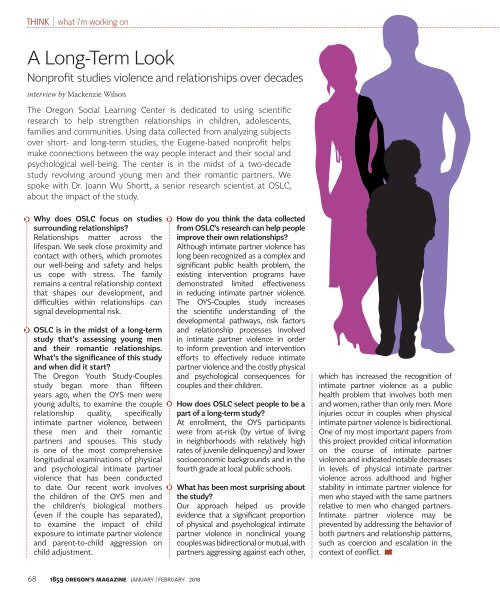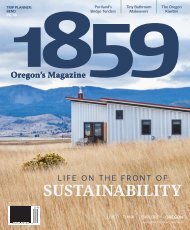Create successful ePaper yourself
Turn your PDF publications into a flip-book with our unique Google optimized e-Paper software.
what i’m working on<br />
A Long-Term Look<br />
Nonprofit studies violence and relationships over decades<br />
interview by Mackenzie Wilson<br />
The Oregon Social Learning Center is dedicated to using scientific<br />
research to help strengthen relationships in children, adolescents,<br />
families and communities. Using data collected from analyzing subjects<br />
over short- and long-term studies, the Eugene-based nonprofit helps<br />
make connections between the way people interact and their social and<br />
psychological well-being. The center is in the midst of a two-decade<br />
study revolving around young men and their romantic partners. We<br />
spoke with Dr. Joann Wu Shortt, a senior research scientist at OSLC,<br />
about the impact of the study.<br />
Why does OSLC focus on studies<br />
surrounding relationships?<br />
Relationships matter across the<br />
lifespan. We seek close proximity and<br />
contact with others, which promotes<br />
our well-being and safety and helps<br />
us cope with stress. The family<br />
remains a central relationship context<br />
that shapes our development, and<br />
difficulties within relationships can<br />
signal developmental risk.<br />
OSLC is in the midst of a long-term<br />
study that’s assessing young men<br />
and their romantic relationships.<br />
What’s the significance of this study<br />
and when did it start?<br />
The Oregon Youth Study-Couples<br />
study began more than fifteen<br />
years ago, when the OYS men were<br />
young adults, to examine the couple<br />
relationship quality, specifically<br />
intimate partner violence, between<br />
these men and their romantic<br />
partners and spouses. This study<br />
is one of the most comprehensive<br />
longitudinal examinations of physical<br />
and psychological intimate partner<br />
violence that has been conducted<br />
to date. Our recent work involves<br />
the children of the OYS men and<br />
the children’s biological mothers<br />
(even if the couple has separated),<br />
to examine the impact of child<br />
exposure to intimate partner violence<br />
and parent-to-child aggression on<br />
child adjustment.<br />
How do you think the data collected<br />
from OSLC’s research can help people<br />
improve their own relationships?<br />
Although intimate partner violence has<br />
long been recognized as a complex and<br />
significant public health problem, the<br />
existing intervention programs have<br />
demonstrated limited effectiveness<br />
in reducing intimate partner violence.<br />
The OYS-Couples study increases<br />
the scientific understanding of the<br />
developmental pathways, risk factors<br />
and relationship processes involved<br />
in intimate partner violence in order<br />
to inform prevention and intervention<br />
efforts to effectively reduce intimate<br />
partner violence and the costly physical<br />
and psychological consequences for<br />
couples and their children.<br />
How does OSLC select people to be a<br />
part of a long-term study?<br />
At enrollment, the OYS participants<br />
were from at-risk (by virtue of living<br />
in neighborhoods with relatively high<br />
rates of juvenile delinquency) and lower<br />
socioeconomic backgrounds and in the<br />
fourth grade at local public schools.<br />
What has been most surprising about<br />
the study?<br />
Our approach helped us provide<br />
evidence that a significant proportion<br />
of physical and psychological intimate<br />
partner violence in nonclinical young<br />
couples was bidirectional or mutual, with<br />
partners aggressing against each other,<br />
which has increased the recognition of<br />
intimate partner violence as a public<br />
health problem that involves both men<br />
and women, rather than only men. More<br />
injuries occur in couples when physical<br />
intimate partner violence is bidirectional.<br />
One of my most important papers from<br />
this project provided critical information<br />
on the course of intimate partner<br />
violence and indicated notable decreases<br />
in levels of physical intimate partner<br />
violence across adulthood and higher<br />
stability in intimate partner violence for<br />
men who stayed with the same partners<br />
relative to men who changed partners.<br />
Intimate partner violence may be<br />
prevented by addressing the behavior of<br />
both partners and relationship patterns,<br />
such as coercion and escalation in the<br />
context of conflict.<br />
68 <strong>1859</strong> OREGON’S MAGAZINE JANUARY | FEBRUARY <strong>2018</strong>

















